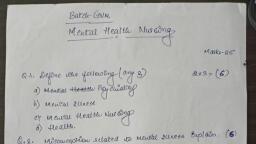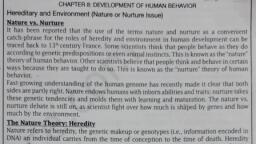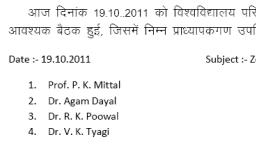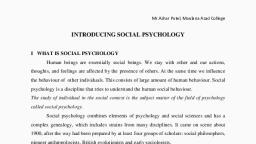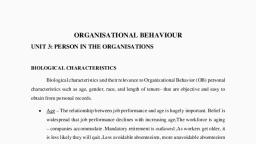Page 1 :
CHAPTER, Biology of, Behavior, The biology of behavior is the study of behavioral Body is represented by physical states and bodily, functions. Our nervous system and glands, which, are an important part of our body are responsible, for our ways of thinking, feeling and doing., * All behaviors have an anatomical and physiolog-, ical basis. Physiological structures, body fluids,, chemicals and mechanical events, all influence, both our overt behavior and our feelings and, experiences. Our mental functions like strong, feelings, emotions, attitudes, motives, thinking,, etc. influence our bodily activities and processes., • Emotions are combination of bodily responses, and mental processes. Body provides energy, to fight or cope; mind contributes to the, understanding, to offer an explanation for ones, own actions or the actions of others. Just as, functions of the nervous system, particularly the, brain. 'Physiological psychology' is the branch of, psychology, which seeks to determine how activity, in the nervous system is related to behavior and the, mind., Many aspects of human behavior and mental, functioning cannot be fully understood without some, knowledge of the underlying biological processes., Our nervous system, sense organs, muscles and, glands enable us to be aware of and adjust to our, environment. Our perception of events depends on, how our sense organs detect stimuli and how our, brain interprets information originating from the, senses., BODY-MIND RELATIONSHIP-, the body produces epinephrine to fight danger,, the mind helps to decide, whether it is needed, or not., MODULATION PROCESS IN HEALTH, AND ILLNESS, * Psychology studies human behavior, which Effects of Bodily Conditions on Mental, involves both the body and the mind. They are, interrelated and interact upon each other. Mental, functions and physical states affect each other., Body and the mind are two aspects of the living,, dynamic and adjusting personality. Mind is • Severe pain reduces the concentration level., regarded as a function of the body; it does not, exist apart from the body. It is the sum total of, various mental processes such as observing,, knowing, thinking, reasoning, feeling, imagining,, remembering, judging, etc. Mind also grows just Physical fatigue affects our mood and reduces, as the body grows., Functioning, * Increased blood pressure causes mental excite-, ment., • Chronic illness causes depression., • Malfunctioning of the endocrine glands may, exert full influence on one's personality, resulting, in lethargy, nervous tension, etc., our motivation, interest and concentration., Scanned by TapScanner
Page 2 :
Biology of Behavior, 15, * Brain injury affects many psychological func- GENETICS AND BEHAVIOR:, tions. At the same time well developed brain HEREDITY AND ENVIRONMENT, leads to the development of better intellectual, functioning., Heredity, Effects of Mental Conditions on Bodily, Functioning, Heredity is considered as "the sum total of inborn, individual traits". Biologically, it has been defined, as "the sum total of traits potentially present in the, • Unpleasant emotions like fear, anger and worry fertilized ovum". According to Douglas and Holland, cause irritability, insomnia, headache, etc., Mental processes are intimately connected to, brain or cortical processes, e.g. depression affects parents, other ancestry or species"., thinking and memory., • Emotional conflicts are responsible for peptic cludes growth, development, reproduction and de-, ulcer, ulcerative colitis, etc., Deep thinking and concentration can cause by which each organism exercises its capacities are, physical strain., • According to Franz Alexander, repressed feel-, ings of hostility and aggression are expressed, through the nervous system and cause hyperten-, sion and cardiac diseases. Repressed feelings of, dependency, wish to receive love, affect para- The life cycle of an individual begins with the fusion, sympathetic nervous system resulting in gastro- of a sperm and ovum. The origin of every human life, intestinal disorders or respiratory disorders., Unconscious motivation and conflicts gives a sperm unites with an ovum, zygote is produced., rise to many physical complaints and neurotic The genes, which are the carriers of distinctive traits, disorders like conversion disorders., "one's heredity consists of all the structures, physical, characteristics, functions or capacities derived from, All organisms possess a life cycle, which in-, cline. Though there is essential unity in life, the ways, different. These individual qualities of organisms, and their basic properties are transmitted by means, of heredity., Mechanism of Heredity, can be traced to a single cell called zygote. When, are present both in the sperm and the ovum. In the, fertilized ovum, there are 23 pairs of chromosomes,, Relationship between body and the mind has, an effect on health and illness. If the relationship half of which are given by the father and the other, is harmonious, it leads to health, while an adverse, relationship leads to illness. If all the body and, mental processes are working within normal range,, the individual will have good health. Disruption in represented by X and Y. The X and Y are called as, any one of the processes will lead to illness., Psychosomatic medicine deals with physical error, aberrations in chromosomes appears. If an, diseases caused by psychological factors. In these, patients, the treatment should be given for both body rather than the normal 46, mongolism (Down's, and mind, e.g. in case of peptic ulcer the treatment syndrome or trisomy 21 anomaly) results. A child, includes both drugs and psychotherapy., The nurse should understand the interrelationship during the prenatal period, which results in a highly, between the body and the mind. She should also complex, multidimensional disorder, in which every, understand the emotional factors underlining the, disease of the patient. It is always necessary to study, the patient's physical and psychological problems in scope, bands of markings appear, representing an, order to provide comprehensive care., half by the mother. While females have 23 pairs, of XX chromosomes, males have 22 pairs of, XX chromosomes plus two single chromosomes, sex chromosomes., Occasionally, through some unfortunate bodily, extra chromosome appears making the total 47, with Mongolism suffers from deceleration of growth, organ is involved., When chromosomes are studied under a micro-, entity called genes, which appear to be the actual de-, Scanned by TapScanner
Page 3 :
Biology of Behavior, 17, Environment, surrounded by amniotic fluid and attached to the, The child inherits the traits and characteristics of his mother by the umbilical cord. Thus, growth of the, parents and forefathers through genes at the time of embryo depends on the nourishment provided by, conception. Therefore, what he possesses at the time the mother. The physiological and psychological, of conception is all due to heredity., After conception, how he develops is the out- nterests, etc. all influence the development of the, come of the interaction between his heredity and en-, vironment. The forces of environment begin to play environmental forces, which are purely external in, their part and influence the growth and development, of an individual right from the time of fertilization, of the ovum by the sperm. Therefore from the envi- External environment: It can be divided into three, ronmental point of view, not only what happens after kinds:, birth is important, but what goes on inside the womb, of the mother after conception is equally significant., Environment covers the social, moral, economi-, cal, political, physical and intellectual factors, which Physical environment: Non-living things like water,, influence the development of the individual from air, housing, soil, climate, heat, light, radiation,, states of the mother during pregnancy, her habits and, child., After birth, the child is exposed to the numerous, nature., O Physical environment, e Biological environment, O Psychosocial environment, time to time., noise, etc. form the physical environment. These, affect the body and mind of the growing child. So,, it is necessary to provide a decent home and locality, The environment is everything that affects the for good physical and mental health of the child., Definitions, individual except his genes., (Boring, Langfield and Weld) Biological environment: It refers to the living, Environment covers all the outside factors that component of man's external environment, which, consists of plants, animals, insects, bacteria and, viruses. It is necessary that the child should be allowed, to grow in a good, healthy biological environment., The child should be kept away from the disease, have acted on the individual, since he began life., (Woodworth), Types of Environment, carrying germs, bacteria and viruses., There are three types of environment that affect the, individual directly or indirectly:, O Intercellular environment, e Intrauterine environment, O External environment, Psychosocial emvironment: It includes cultural val-, ues, customs, habits, beliefs, attitudes, morals,, religion, education, occupation, social and political, organization, etc. Parents, members of the family,, friends, classmates, neighbors, teachers, mass com-, Intercellular environment: It relates to embryonic munication and recreation are also included in this, development. The cytoplasm is in the intercellular environment. These different environmental forces, environment, because the genes surrounded by it are have a desirable impact upon the physical, social,, influenced by and in turn influence its characteristics. emotional, intellectual, moral and aesthetic develop-, Endocrine glands and hormones also produce ment of an individual. Their influence is a continu-, intercellular influence. Many congenital deformities ous one, which begins with the emergence of life and, are the result of overactive or underactive endocrine goes on till death., function., One example of the influence of environment, upon potential height is found among the first and, Intrauterine environment: It shelters the baby during second generations of Japanese people in the United, prenatal life. In the womb the growing organism is States (US). The children are generally taller than, Scanned by TapScanner
Page 4 :
18, Psychology for Nurses, their parents, because they have had the advantages interaction of heredity and the environment. Within, of better food and better living conditions. Another this interaction, our genetic endowment for many, example is the children of third world countries characteristics provides us with a reaction range of, whose growth and development have been stunted possible levels that we may ultimately reach depending, on the quality of our experience in the environment., many of these children show marked improvement Heredity and environment are interdependent forces., The influence of heredity and environment are so, interrelated that they are practically inseparable., The knowledge of the mechanism of heredity, and the influence of environment on the personality, development is important for a nurse to understand, by drought and famine. As food becomes available,, in their physical conditions., Interaction Between Heredity and, Environment, Each individual enters the world with certain the behavior of a patient., hereditary characteristics transmitted to him through, his parents. He grows up in a certain environment, with its human, social and material surroundings. BRAIN AND BEHAVIOR: NERVOUS, Everything he does as a child or adult results from SYSTEM, NEURONS AND SYNAPSE, the complex interactions between heredity and, environment., • The entire behavior is effectively managed and, controlled by the coordination and functioning of, the nervous system., • How we will behave in a particular situation, depends upon the judgment of our brain., * The sense impressions, which are received, through the sense organs, do not bear any, significance unless they are given a meaning by, the nervous system., * The relative influence of heredity and environ-, ment differs from one individual to another and, from one human trait or condition to another., Heredity and environment are interdependent, forces. Inheritance is an important factor in the, development of the artistic abilities like music., Heredity supplies the potential talent, while, favorable environment brings it out., • Heredity and environment are equally important, in shaping the temperament of the child. Heredity, lays down the essential foundations, while, environment can change these foundations for, better or worse., • Learning also to a great extent is controlled by, the nervous system., • Heredity provides the raw material from which, a person is made. How the material is molded,, and what he becomes depends chiefly on the, environment. Good materials placed in good, hands result in a fine finished product. Poor, material, no matter how carefully fashioned can, never become a first rate product., Our inheritance prescribes the limits, beyond, which it may not be possible for any individual, to develop, however wholesome and stimulating • The process of growth and development is, the environment may be., Today no one believes that nature or nurture alone,, completely determines the course of our development. • The personality of an individual is greatly influenced, Psychologists agree that development is shaped by the, * The proper growth and development of nerve, tissues and nervous system as a whole helps in, the task of proper intellectual development., • Any defect in the spinal cord or the brain, seriously affects the intellectual growth., • The emotional behavior is also influenced by, the nervous system, especially at the time of, anger, fear and other emotional changes. During, emotional outbursts, nerve tissues cause the, change in the secretion of hormones by some, glands and consequently influence the emotional, behavior of an individual., also directly and indirectly controlled by the, functioning of the nervous system., through the mechanism of the nervous system., Scanned by TapScanner


